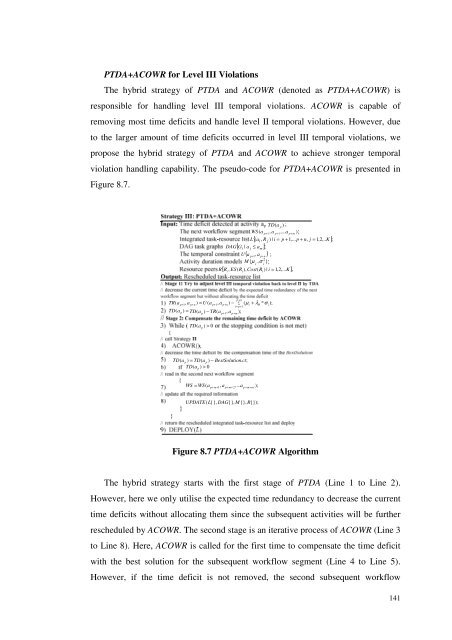Xiao Liu PhD Thesis.pdf - Faculty of Information and Communication ...
Xiao Liu PhD Thesis.pdf - Faculty of Information and Communication ...
Xiao Liu PhD Thesis.pdf - Faculty of Information and Communication ...
Create successful ePaper yourself
Turn your PDF publications into a flip-book with our unique Google optimized e-Paper software.
PTDA+ACOWR for Level III Violations<br />
The hybrid strategy <strong>of</strong> PTDA <strong>and</strong> ACOWR (denoted as PTDA+ACOWR) is<br />
responsible for h<strong>and</strong>ling level III temporal violations. ACOWR is capable <strong>of</strong><br />
removing most time deficits <strong>and</strong> h<strong>and</strong>le level II temporal violations. However, due<br />
to the larger amount <strong>of</strong> time deficits occurred in level III temporal violations, we<br />
propose the hybrid strategy <strong>of</strong> PTDA <strong>and</strong> ACOWR to achieve stronger temporal<br />
violation h<strong>and</strong>ling capability. The pseudo-code for PTDA+ACOWR is presented in<br />
Figure 8.7.<br />
R<br />
TD( a p<br />
)<br />
WS ( a<br />
p+<br />
1,<br />
a<br />
p+<br />
1,...<br />
a<br />
p+<br />
m<br />
)<br />
L{ ( ai , R j ) | i = p + 1,... p + n,<br />
j = 1,2,.. K};<br />
DAG{ Gi<br />
| a j ≤ am}<br />
U ( a p + 1,<br />
a p + n<br />
)<br />
2<br />
M{<br />
µ , σ }<br />
i i<br />
i i<br />
i<br />
,...<br />
{ R , ES(<br />
R ), Cost(<br />
R ) | i = 1,2 K}<br />
p+<br />
n<br />
TR(<br />
a , ) ( , ) ∑<br />
p+ 1<br />
a<br />
p+<br />
n<br />
= U a<br />
p+<br />
1<br />
a<br />
p+<br />
n<br />
− ( µ<br />
i<br />
+ λθ<br />
* σ<br />
i<br />
);<br />
i=<br />
p+<br />
1<br />
TD ( a p<br />
) = TD ( a<br />
p<br />
) − TR(<br />
a<br />
p+<br />
1,<br />
a<br />
p+<br />
m);<br />
TD( ) > 0<br />
a p<br />
TD( a<br />
p<br />
) = TD(<br />
a<br />
p<br />
) − BestSolution.<br />
ct;<br />
TD( ) > 0<br />
a p<br />
WS = WS ( ap+<br />
m+<br />
1,<br />
ap+<br />
m+<br />
2,...<br />
a<br />
p+<br />
m+<br />
m'<br />
);<br />
UPDATE( L{},<br />
DAG{},<br />
M{},<br />
R{});<br />
Figure 8.7 PTDA+ACOWR Algorithm<br />
The hybrid strategy starts with the first stage <strong>of</strong> PTDA (Line 1 to Line 2).<br />
However, here we only utilise the expected time redundancy to decrease the current<br />
time deficits without allocating them since the subsequent activities will be further<br />
rescheduled by ACOWR. The second stage is an iterative process <strong>of</strong> ACOWR (Line 3<br />
to Line 8). Here, ACOWR is called for the first time to compensate the time deficit<br />
with the best solution for the subsequent workflow segment (Line 4 to Line 5).<br />
However, if the time deficit is not removed, the second subsequent workflow<br />
141
















